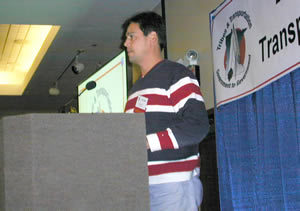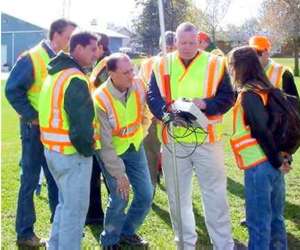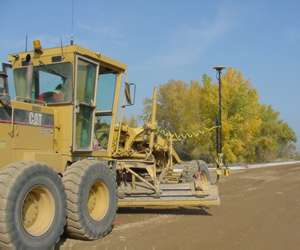 |
 |
|
 |
Tribes and Transportation conference focuses on partnerships |
 |
 |
 |
Carl Dagen, Bois Forte Band of Chippewa public works director, address
the group. Prior to his position with Bois Forte, Dagen worked for Mn/DOT
as a SEEDS program employee and graduate engineer. Photo by Kay Korsgaard
|
The 2003 Tribes and Transportation Conference, held earlier this month at the
Bois Forte Reservation in northern Minnesota, built on the groundwork laid at
the 2002 Tribes and Transportation Summit.
At the 2002 summit, representatives from Mn/DOT, the FHWA and 10 Minnesota
tribes signed the Government
to Government Transportation Accord with the goal of improving cooperation
between agencies working on the development, maintenance and operation of transportation
systems on or near tribal land.
"One of the provisions of the accord was that the various government agencies
meet at least annually to build on the partnerships that were agreed to in 2002,"
said Linda Aitken, Mn/DOT tribal liaison.
The 2003 conference was the first of those meetings.
While the 2002 summit was attended largely by tribal and other governmental
leaders and focused on forging partnerships, this year’s conference focused
on day-to-day issues and practical ways that government agencies can work together
to improve transportation services.
In response to suggestions that the conference provide more opportunities for
group interaction, a "get to know you" session was offered.
"In this session attendees broke into groups based on geographic location
to talk about transportation issues in their area," Aitken said. "In
several groups the conversation moved from theoretical discussions about a transportation
challenge to beginning to seek solutions and assigning group members tasks to
move forward with implementing a solution.
"For example, in the group I attended, we started to discuss the Prairie
Island Reservation, which is on an island, and issues relating to emergency
evacuation," Aitken said. "The group quickly moved beyond identifying
the challenge to working in partnership to decide how to involve the right people
to begin seeking a solution."
Carl Dagen, Bois Forte public works director, agreed.
"Attendees were very interested in partnering," he said. "We
all see our resources diminishing and realize we can share resources to get
the job done.
"We gained a lot of ground at the 2002 summit and continued that work
at this conference," he added. "We are an open slate – where we go
from here is up to the tribes and other agencies."
Also new at this year’s conference were participants from at least eight counties,
Aitken said.
"Participants at the summit told us that transportation issues on tribal
reservations involve more than just Mn/DOT, the FHWA and Minnesota tribes. We
listened and included counties and other units of government in this year’s
conference," she said.
Other breakout and large-group sessions focused on common areas that concern
the agencies, including casino signing, maintenance, employment, TEA-21 reauthorization
and transportation planning.
In addition, conference participants attending the "Tribes and Transportation
Handbook" session had the opportunity to preview and offer feedback on
a Web site in development for the handbook. The Web site is in development and
will go live early next year.
By Kay Korsgaard
|
back

|
 |
New traffic system may improve driver behavior in merge situations |
 |
 |
Fifteen percent of drivers admitted to straddling lanes in order to block late
merges in construction zones, according to a recent Mn/DOT study.
To address the more than 2,700 crashes and 18 fatalities occurring in highway
construction zones last year, Mn/DOT surveyed 800 Minnesotans statewide to better
understand the behaviors and attitudes that trigger driving decisions in merging
situations as drivers enter a work zone.
"Our goal is to increase safety in work zones by reducing the confusion
and frustration drivers often experience when merging," said William Servatius,
Office of Construction. "Many times crashes occur due to aggressive driving,
abrupt lane changes or sudden stops, so we want to help drivers make intelligent
choices while traveling through our work zones."
In an attempt to minimize the problems discovered in the research, Mn/DOT also
conducted a month-long field study on Hwy 10 in Anoka to assess a new dynamic
late merge system, a traffic control strategy to improve merging at lane closures.
"The fully automated system using remote traffic microwave sensors and
a Doppler radar provides instructions to drivers via changeable message signs
on when to merge and how to merge according to the current state of traffic,"
said Craig Mittelstadt, Mn/DOT’s work zone safety specialist. "For example,
if traffic is heavy, the system will instruct motorists to use both lanes and
take turns once they’ve reached the defined merge point just before the lane
closure."
This strategy often referred to as the "zipper" improves traffic
flow, reduces conflicts and will decrease the number of crashes when traffic
demand exceeds the capacity of a single lane closure.
"We want drivers to know that under normal traffic speeds, they should
try to merge early to avoid unsafe merging maneuvers; however, when traffic
is slow, drivers should use both lanes all the way to the definite merge point,"
said Servatius.
"We can’t completely rid the roads from congestion in a work zone, but
data from the study revealed this method shortened queue lengths by 35 percent
and reduced lane changing conflicts," said Mittelstadt. "We also hope
for a decline in crashes and aggressive driving behavior."
Minnesota is one of the first states to use the dynamic late merge system and
plans are to continue this research in the next construction season.
"People have been trying for years to research the proper way to merge,
but there are so many factors to consider," said Servatius. "It’s
difficult to say what’s the ‘right’ way – instead we’re looking for the best
way."
By Daneeka Marshall-Oquendo
|
back

|
 |
State officials announce tow-away zones on I-94, I-35W freeway corridors |
 |
 |
The Minnesota State Patrol and Mn/DOT announced this week the development of
tow-away zones for stalled vehicles on the shoulders of I-94 and I-35W through
the downtown Minneapolis freeways.
The tow-away zones extend from I-394 to Hiawatha Avenue (Hwy 55) on I-94 and
from Lake Street to Washington Avenue on I-35W. Signs on the freeway designate
the tow-away zones.
"Stalls on the shoulders are a hazard to drivers, troopers and the vehicle
owner," said State Patrol Capt. Tom Fraser. "We need to keep traffic
moving freely and safely, so it’s in everyone’s best interest to clear obstacles
as soon as possible."
Occupants who remain in a stalled vehicle will have two hours to arrange towing
if the vehicle doesn’t present an immediate hazard. Vehicles left on the shoulder
will be towed as soon as state troopers can check the vehicle and notify a towing
company.
"A stalled vehicle on the shoulder can reduce freeway capacity up to five
percent," said Jim Kranig, director of Mn/DOT’s Regional Transportation
Management Center in Roseville. "Enforcement of tow-away zones will help
keep the bus lanes open, minimize congestion and maximize the number of vehicles
these corridors can handle."
The State Patrol and Mn/DOT urge drivers to stay with their stalled vehicles,
call for help and wait for a state trooper or a member of Mn/DOT’s Freeway Incident
Response Safety Team to arrive.
By Mary Meinert
|
back

|
 |
New diversity council unites several efforts |
 |
 |
 |
This image is part of the new Central Office diversity council's graphic
identity.
|
A new agency-wide diversity council has been formed as a result of Mn/DOT’s
strategic direction to work more efficiently in all businesses practices and
processes.
The 23-member council consists of one manager and one non-manager from each
division, district representatives and three at-large members. Each member will
act as a liaison between their respective areas and the council.
"In previous years, there were approximately three diversity committees
in just Central Office alone," said Program Management Director Randy Halvorson,
who serves as the council chair. "By creating one council with representatives
from the different areas of the agency, we can reduce duplication of efforts
and make the agency’s use of committees more efficient."
The diversity activities in the districts will continue, but will receive a
stronger support role from the council to help integrate diversity into the
workplace and standard business practices.
"As the council develops diversity training and educational programs for
the agency, we will need to work even more closely with the districts’ diversity
committees to ensure a consistent diversity message departmentwide," said
Halvorson.
The council is currently reviewing Mn/DOT’s Diversity Strategic Plan that outlines
the strategies and tactics Mn/DOT will use to diversify its workforce, establish
hiring goals and provide measurable means to measure diversity efforts.
"We want to be sure this is a solid plan that can be easily comprehended so
that everyone understands their roles and responsibilities," said Mike
Garza, director, Office of Business and Support Services. "It’s up to all
of us to increase the value of diversity in the workplace so we can better serve
the diverse customers who use our products and services."
The council will also continue to sponsor cultural awareness events to help
employees gain a better respect for other employees’ values, beliefs and traditions.
"These events will be structured differently then they have been in the
past," said Halvorson. "It’s nice to be entertained, but more importantly,
we want this to be a forum for employees to learn. The more understanding employees
have about other employees, the less time and fewer resources are needed to
resolve conflicts."
Some event topics the council plans to provide include Communicating Across
Cultures, Managing Diverse Work Teams, Eliminating Bias During an Interview,
Diversity Means More than Race and Gender, and Managing Conflict.
Subcouncils comprised of all interested employees will be used to help implement
these activities and events.
For more information about the new diversity council or to contact the members,
visit the diversity Web site at http://ihub.dot.state.mn.us/diversity/.
By Daneeka Marshall-Oquendo
|
back

|
 |
Human Resources completes managers’ classification study |
 |
 |
The Office of Human Resource Operations has completed a review of management
positions in all Mn/DOT districts, divisions and offices as part of the Managers
Classification Study. As indicated in an Oct. 22 memo from Doug Differt to all
managers, the effective date for implementation of the study is Nov. 5. However,
final confirmation of the results of the study to individual managers is still
under development.
"Anything that affects people’s positions is a challenge," said Kevin
Gray, director, Finance and Administration Division. "It’s been the goal
of the department to get the right people in the right positions in the right
way."
There have been many questions about the study and resulting changes. Gray
and Rich Peterson, director, Office of Human Resources Operations, provided
answers to some of these questions:
What was the need for the study?
The commissioner, deputy commissioner and division directors recognized that
because of recent restructuring and impacts of changes made over time, some
management work assignments didn’t match position descriptions.
What was the goal of the study?
To assess impacts of restructuring on managers' responsibilities and to ensure
that management classifications are equitable within Mn/DOT and also are in
line with those in other state agencies.
When did the study begin?
The Managers Classification Study began in March 2003.
How many positions were reviewed?
A total of 141 positions were reviewed.
How many positions will be affected?
A few positions have been designated as non-managerial and will be reclassified
accordingly. However, the majority of manager positions will remain unchanged.
How was the evaluation conducted?
A structured Hay review process was conducted by a team of human resources
professionals from Mn/DOT’s Office of Human Resources Operations, the Department
of Employee Relations and other state agencies. Managers were asked to review
and update their position descriptions to reflect changes to their duties and
responsibilities. The study team then developed recommendations about which
job classifications best matched managers’ duties.
What is a Hay review?
The Hay method systematically measures job content in order to evaluate and
rank jobs consistently within Mn/DOT and other state agencies. Positions are
typically Hay-evaluated when a new class may be needed, if the appropriate level
of a position is difficult to determine, a class has not been reviewed for some
time, the class concept has changed or if the position is part of a class review.
Will there be further evaluations of positions?
Some management positions that were not part of this study may be reviewed
at a later date. There will also be ongoing scrutiny of manager vacancies and
needs in order to retain integrity of positions and ensure agency accountability.
For more information about the study, contact Peterson at 651/296-3648.
By Donna Lindberg
|
back

|
 |
High-tech engineering system helps guide ‘dozer and grader operators as they construct
roads |
 |
 |
 |
A contractor’s employee demonstrates the use of Geopak survey equipment
during the field demonstration at Willmar. Photo by Jon Mohrmann.
|
They’re an odd sight—creaking, mud-splattered graders and bulldozers that bristle
with saucer-shaped GPS receivers, transponders and other high-tech gear as they
rumble through a highway project area.
Instead of following contours and elevations marked by wooden "blue-top"
stakes, the grading operators take direction from pre-programmed information
they receive electronically in the cab.
The directions come via plans created by Mn/DOT designers using the Geopak
engineering software system.
The process, known as machine control, directs the operators actions by using
lights and other signals to guide grading levels and other operations to improve
accuracy and efficiency.
A red light, for example, tells operators they need to excavate more or add
more fill to meet project specifications.
Mn/DOT has used the construction software program for engineering and design
work since 1990. Now the department plans more extensive use of the system.
Lou Barrett, supervisor of the Computer Aided Design and System Management
Units, Technical Support, said Willmar/District 8 has pioneered wider use of
the program in areas such as surveys, right of way and hydraulics on its Hwy
23 reconstruction project.
 |
A grader using GPS equipment and Geopak software was displayed on Oct.
15 when staff from Technical Support and Willmar/District 8 held a field
demonstration for representatives from the N. D., Iowa and Nebraska
DOTs. Photo by Sandy East.
|
She said project designers used the software program to design and build drainage
ponds built for the project to demonstrate its feasibility.
"The system is very accurate and helps save time and money," said
Paul Jurek, Hwy 23 project manager. "It enables operators to know exactly
where they are, specifies the required slope and guides cut and fill operations
to within three-tenths of a foot."
Jurek said planners used the system to design curb, gutter and sidewalk installations
in downtown Spicer as well as several other uses.
Using Geopak for all phases of construction saves inspection time and improves
the accuracy of excavation and other construction project operations.
"Hand-held GPS monitors make it easy to check construction and are a lot
easier to carry around than 200 pounds or so of paper plans," Barrett said.
She said using Geopak saved between 400 to 500 hours of survey time, for example,
when building the construction ponds.
"Now we can use Geopak from beginning to end on a project—from concept
to construction," Barrett said.
By Craig Wilkins
|
back

|
 |
Holland, Prescott, Tschida named as fiscal and administrative managers |
 |
 |
Jerry Holland, Mary Prescott and Pam Tschida were appointed to serve as fiscal
and administrative services managers for Mn/DOT’s six divisions and the Commissioner’s
Office.
In their new positions, they provide leadership and managerial direction for
the divisions’ administrative and financial operations as well as their human
and information resources functions.
Holland supports the District Operations Division, a role he has performed
since 1998. His previous assignments include director of finance with the Metro
District and business manager with the former Oakdale District. Before joining
Mn/DOT in 1976, Holland served as the assistant comptroller at Minnesota State
University-Moorhead. He holds a bachelor’s degree in accounting and business
administration from the university.
Holland’s office is in Room 430; telephone is 651/296-8176.
Prescott will support Engineering Services and the Operations, Safety and Technology
divisions. Before accepting her new position, Prescott served with the Innovative
Construction Initiative team as administrative director with the Program Support
Group.
Before joining Mn/DOT in 1996, Prescott was a program supervisor with State
Services for the Blind and business manager with the Attorney General’s Office.
She holds a bachelor’s degree in business administration from Metropolitan
State University.
Her office is in Room 429; telephone 651/297-2250.
Tschida, who previously led the Business Services Section, will provide support
for the Finance and Administration, State Aid and Program Management divisions.
She will also support the Commissioner’s Office. A Mn/DOT employee since 1967,
Tschida held several administration posts during her career including those
with Technical Support and the Office of Maintenance.
Tschida’s office is located in Room 433; she may be reached at 651/296-3261.
By Craig Wilkins
|
back

|
 |
National association honors Aeronautics’ Erickson, Dellwo |
 |
 |
The National Business Aircraft Association honored two Office of Aeronautics
employees for performance excellence.
Pilot Barry Erickson was cited for completing 4,500 consecutive hours of incident-
and accident-free flight. Erickson has been a pilot with Aeronautics since 1984.
He also served as a pilot with the Minnesota Air National Guard jet fighter
wing based in Duluth until his retirement in 1994.
Vivian Dellwo, an aircraft dispatcher, was honored for 12 years of contributing
to the safety of business aircraft operations in Minnesota.
"Barry and Vivian are tremendous assets to Aeronautics and to Mn/DOT,"
said Tim Valento, Aeronautics’ chief pilot. "They are true professionals
who deserve this special recognition."
|
back

|
 |
Funeral services held for District 3’s Curt Eastlund |
 |
 |
Funeral services were held today for Curt Eastlund, District 3 project development
engineer, who died Oct. 24 when another vehicle collided with his pick-up truck
as he drove to work. The driver of the other vehicle was also killed.
The funeral was held at Holy Cross Catholic Church in Onamia.
Eastlund, 49, joined Mn/DOT in 1992 as a graduate engineer. Before joining
Mn/DOT, Eastlund served in the U.S. Navy and worked as an engineer with SRF
Inc. after earning a civil engineering degree from the University of Minnesota
in 1989.
Bob Busch, District 3 engineer and a member of the same Mn/DOT graduate engineer
rotation class, said Eastlund touched people’s lives no matter how they knew
him.
"His laughter and sense of humor left an impact, in addition to his ability
to connect with all kinds of people," Busch wrote to district employees.
"He had the ability to quickly assess an issue and calm down even the most
distraught and agitated citizens.
"Although Curt was only 49 years old, he lived life to the fullest. Trying
to keep up with him was nearly impossible. Curt’s schedule was always full –
even when he was on vacation, staff members found him attending public meetings
and checking in with co-workers. At a recent meeting, he reminded his peers
of the importance of priorities in life – taking time to be with family and
friends.
"Curt spent his District 3 career focused on developing highway improvement
projects that would expand the district’s high-volume, two-lane roadways in
an effort to reduce crashes, fatalities and injuries.
"Since joining the district in 1995, Curt was instrumental in guiding
many high-profile, sometimes controversial, highway improvement projects through
the public involvement and project development process. One of Curt’s talents
was his ability to bring together various and diverse partners—an achievement
marked by the cooperative venture of the proposed Highway 371 welcome center
and rest area."
Eastlund is survived by his spouse, Shannon Smith, and three sons from a previous
marriage.
|
back

|
 |
Health insurance sign-up to take place Dec. 1-14 |
 |
 |
Due to delays in settling state employee labor contracts, the annual State
Employee Group Insurance Program'ss open enrollment period, which normally occurs
in October, will be held Dec. 1-14 this year.
Open enrollment materials with information on insurance offerings, rates and
other details will be mailed to employees before Dec. 1.
Visit the DOER Web site at http://www.doer.state.mn.us/2003bargaining/update.htm
for future updates on open enrollment and bargaining.
If you have questions about open enrollment 2003, call the Employee Insurance
Division at 651/296-2457.
|
back

|
 |
|
 |



